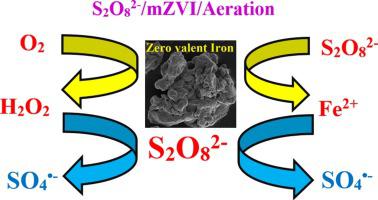Journal of Water Process Engineering ( IF 6.3 ) Pub Date : 2020-05-29 , DOI: 10.1016/j.jwpe.2020.101321 Farshid Ghanbari , Mahtab Riahi , Babak Kakavandi , Xiaoting Hong , Kun-Yi Andrew Lin

|
Water pollution by organic dyes has been considered by water and wastewater engineers. Several methods have been suggested in literature especially advanced oxidation processes. Peroxydisulfate (PDS)-based processes are a powerful technique for the degradation of organic pollutants. Micro-zero valent iron (mZVI)/aeration is also a simple method for the generation of Fenton reagent. In this study, PDS/mZVI/aeration was used for the first time to degrade Acid Blue 9 (AB9). Operating parameters, various anions, iron release and reaction kinetic were comprehensively investigated. A rapid degradation of AB9 was observed after only 10 min under conditions of PDS = 1.5 mM and mZVI = 0.5 g/L. Pseudo-first order kinetic model was fitted for AB9 degradation with the rate constant of 0.2039 min−1. In contrast with mZVI, zero valent aluminum was ineffective to activate PDS. Scavenging tests demonstrated that sulfate radical (SO4 -) was dominated for the degradation of AB9. Carbonate and nitrite anions almost completely suppressed AB9 degradation. The negative effect of anions on the process was based on this order CO32− > NO2− > I− > H2PO4− > Br− > Cl− > NO3− ≥ SO42−. Carboxylic acids generated arise from AB9 degradation were monitored. The results showed that further oxidation led to the generation of the small molecules of carboxylic acids. Around 60% of organic carbon of AB9 was mineralized during 120 min reaction. 7.0% of mZVI was released in the solution. FESEM, EDS, and XRD analyses showed that mZVI was oxidized to Fe2O3. Finally, PDS/mZVI/aeration showed a simple and efficient process for degradation of organic dye.
-) was dominated for the degradation of AB9. Carbonate and nitrite anions almost completely suppressed AB9 degradation. The negative effect of anions on the process was based on this order CO32− > NO2− > I− > H2PO4− > Br− > Cl− > NO3− ≥ SO42−. Carboxylic acids generated arise from AB9 degradation were monitored. The results showed that further oxidation led to the generation of the small molecules of carboxylic acids. Around 60% of organic carbon of AB9 was mineralized during 120 min reaction. 7.0% of mZVI was released in the solution. FESEM, EDS, and XRD analyses showed that mZVI was oxidized to Fe2O3. Finally, PDS/mZVI/aeration showed a simple and efficient process for degradation of organic dye.
中文翻译:

通过曝气强化过氧二硫酸盐/微粒-零价铁过程降解有机污染物:动力学研究,阴离子的机理和作用
水和废水工程师已经考虑了有机染料对水的污染。文献中已经提出了几种方法,特别是高级氧化方法。基于过氧二硫酸盐(PDS)的工艺是降解有机污染物的有力技术。零价铁(mZVI)/曝气也是生成Fenton试剂的一种简单方法。在这项研究中,首次使用PDS / mZVI /曝气降解酸性蓝9(AB9)。全面研究了操作参数,各种阴离子,铁的释放和反应动力学。在PDS = 1.5 mM和mZVI = 0.5 g / L的条件下,仅10分钟后即可观察到AB9快速降解。拟一级动力学模型适用于AB9降解,速率常数为0.2039 min -1。与mZVI相比,零价铝不能有效激活PDS。清除测试表明,硫酸根(SO 4- )是AB9降解的主要因素。碳酸盐和亚硝酸盐阴离子几乎完全抑制了AB9的降解。在处理的阴离子的负面影响是基于该顺序CO 3 2- > NO 2 - >我- >ħ 2 PO 4 - >溴- >氯- > NO 3 - ≥SO 4 2-。监测由AB9降解产生的羧酸。结果表明,进一步的氧化导致生成羧酸的小分子。在120分钟的反应过程中,约有60%的AB9有机碳矿化。溶液中释放出7.0%的mZVI。FESEM,EDS和XRD分析表明mZVI被氧化为Fe 2 O 3。最后,PDS / mZVI /曝气显示了一种简单有效的降解有机染料的方法。
)是AB9降解的主要因素。碳酸盐和亚硝酸盐阴离子几乎完全抑制了AB9的降解。在处理的阴离子的负面影响是基于该顺序CO 3 2- > NO 2 - >我- >ħ 2 PO 4 - >溴- >氯- > NO 3 - ≥SO 4 2-。监测由AB9降解产生的羧酸。结果表明,进一步的氧化导致生成羧酸的小分子。在120分钟的反应过程中,约有60%的AB9有机碳矿化。溶液中释放出7.0%的mZVI。FESEM,EDS和XRD分析表明mZVI被氧化为Fe 2 O 3。最后,PDS / mZVI /曝气显示了一种简单有效的降解有机染料的方法。











































 京公网安备 11010802027423号
京公网安备 11010802027423号